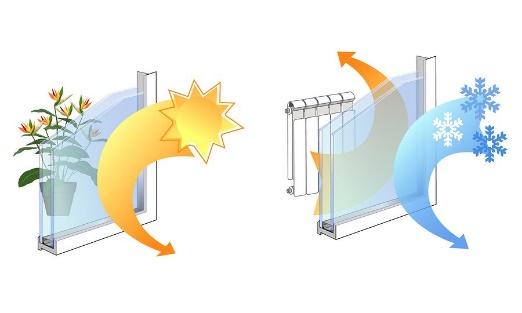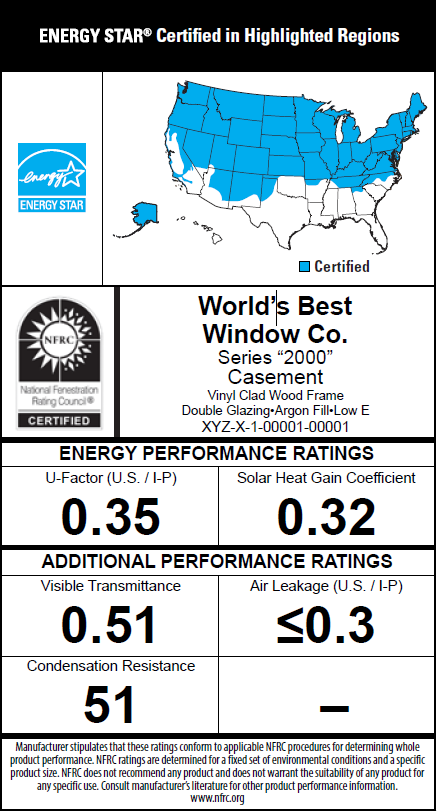Window Ratings Explained
The very first thing to remember as you’re starting to sort through window ratings is that just about every aspect of a window’s performance can be relatively easily measured. Don’t let yourself get all distracted by a 0.02 difference in one rating or another. Instead, focus on the overall rating of the window, the manufacturer’s reputation, and independent certifications and verifications from trusted authorities — such as the National Fenestration Rating Council (NFRC) and American Architectural Manufacturers Association (AAMA).
Heat Gain and Loss
Windows, doors, skylights can gain and lose heat through:
- Direct conduction through the glass or glazing, frame, and/or door
- The radiation of heat into a house (typically from the sun) and out of a house from room-temperature objects, such as people, furniture, and interior walls
- Air leakage through and around them.
Window label values
U-Factor
U-value is a scientific calculation that measures the rate at which heat flows through 1 square foot of material; it measures how well a product keeps heat from escaping a building or home. The lower the U-factor of a window, the better it is at reducing heat transfer; that is, less heat will be lost. The U-factor refers to the energy efficiency of the entire window assembly. The lower it is, the more energy-efficient it is considered to be. U-factor performance is especially important in how it impacts energy efficiency during the winter heating season in colder climates.
Solar Heat Gain Coefficient – SHGC
Solar heat gain coefficient (SHGC) is the fraction of solar radiation admitted through a window, door, or skylight — either transmitted directly and/or absorbed, and subsequently released as heat inside a home. The lower the SHGC, the less solar heat it transmits and the greater its shading ability. A product with a high SHGC rating is more effective at collecting solar heat during the winter. A product with a low SHGC rating is more effective at reducing cooling loads during the summer by blocking heat gain from the sun. Your home’s climate, orientation, and external shading will determine the optimal SHGC for a particular window, door, or skylight.
Visible Transmittance – VT Rating
Visible transmittance (VT) is a fraction of the visible spectrum of sunlight (380 to 720 nanometers), weighted by the sensitivity of the human eye, that is transmitted through the glazing of a window, door, or skylight. A product with a higher VT transmits more visible light. VT is expressed as a number between 0 and 1. The VT you need for a window, door, or skylight should be determined by your home’s daylighting requirements and/or whether you need to reduce interior glare in a space.
Air Infiltration or Air Leakage
Air leakage is the rate of air movement around a window, door, or skylight in the presence of a specific pressure difference across it. It’s expressed in units of cubic feet per minute per square foot of frame area (cfm/ft2). A product with a low air leakage rating is tighter than one with a high air leakage rating. Note that air leakage also depends on proper installation of a window, which is assumed in all ratings.
Condensation Resistance – CR Rating
Known as the Condensation Resistance Factor or CRF under AAMA, it is based on a dimensionless scale generally in the range of 30 – 80 with a higher number representing a greater resistance to condensation formation.
Overall window performance
If you’re not a physics teacher and not all that interested in delving into the minutiae here, you may be looking for a way to tell if a specific product is “pretty good” without spending a tremendous amount of time learning all about the specific window ratings and that logic makes sense. To accomplish that goal, look for a product that meets the Energy Star requirements for your climate zone. You can also learn about the structural performance of a product by looking at its AAMA rating and do a search for the specific manufacturer and window product. All major products are AAMA certified, so if you come across one that isn’t, or if a company won’t tell you the rating, that would be a major red flag.
Energy Star is a helpful program to determine if a replacement window is energy efficient. If a product meets the Energy Star criteria and it’s AAMA gold-certified then you’ve got yourself a great window. If you want to get a deeper feel for how one product compares to another, dig on into the window ratings.
Boost your energy efficiency with Ayars
Looking to decrease your energy bills while seriously boosting your home’s aesthetic? Get in touch with the team at Ayars Complete Home Improvements and we’ll help you choose the windows that are most ideal for you.







